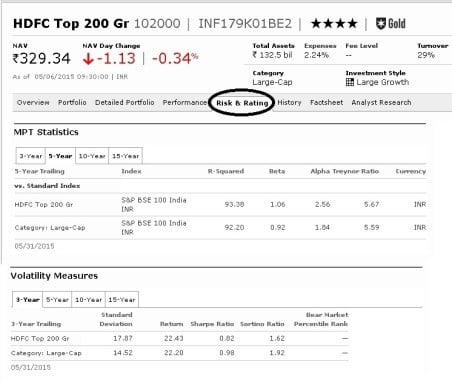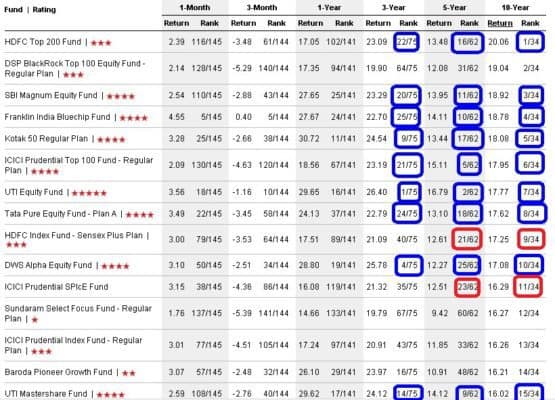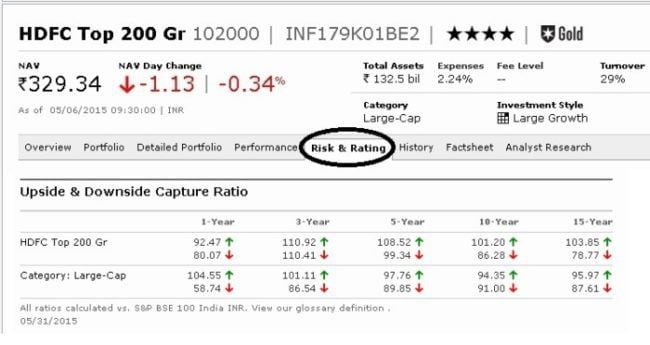Last Updated on August 30, 2021 at 3:41 pm
In this third and final part on “how to select an equity mutual fund”, we will consider different ways in which one ‘make a choice’ from a shortlist.
Yes, there are several ways to choose from a shortlist, just like there are several ways to make a shortlist. You will have to take your pick. It is easy to do so. All you need to do is to try and sell your pick to your rational side. That is you must be able to justify your method to yourself. Forget about what others think.
Before we proceed, a suggestion to read the first two stages in the selection process, if you have not done so:
(1) The objective or the preamble for fund selection
Join 32,000+ readers and get free money management solutions delivered to your inbox! Subscribe to get posts via email! (Link takes you to our email sign-up form)
🔥Want to create a complete financial plan? Learn goal-based investing? Exclusive access to our DIY tools? Increase your income with your skills? Enjoy massive discounts on our robo-advisory tool & courses! 🔥
Note: The title of this post is ‘making a choice’ and not finding the best fund from the shortlist. This means that no matter how hard you try to shorten your shortlist, you will not be able to do so (if you objectively go about it).
So from a 10-15 fund shortlist, you will end with maybe a 2-5 fund shortlist. You will have to pick one from this. There is no other way of doing this.
This is a long post. A total of 7 methods are listed. Not all methods are (or can be) discussed in detail. Please consult the links provided for more information.
Method 1: Just pick one from the shortlist!
Method 2: Using short-term risk-return metrics
Method 3: Using long-term risk-return metrics
A. With Morningstar India
B. With the freefincal risk-return analyzer
Method 4: Using downside capture ratios
A. With Morningstar India
B. With the freefincal risk-return analyzer
Method 5: With rolling returns
Method 6: With information ratio
Method 7: With Ulcer index
I urge you read/consider all the methods, and develop your own. A combination of methods can also be considered.
Method 1: Just pick one from the shortlist!
By the time you are finished with this post, chances are that you might agree that doing an “Eeny, meeny, miny, moe” from the shortlist is a pretty good method. Why not?
Think about it, you have made a shortlist based on consistent performers based on 3, 5 and 10-year returns. So why not pick one from this list? The risk associated with the returns obtained will be neglected, but this method is any day better than what many people do: ask for best fund names or ask other people to pick from their shortlist.
If the following appears a bit complicated to you, adopt method 1, but do not fail to learn “how to review your mutual fund portfolio“.
If so, why can’t I use star ratings as a guide? From my experience, people who start using star ratings do not know when to stop. They would compare peers without checking the actual performance of their portfolio. I can never feel comfortable with such a strategy. Personal finance is an individual race.
Not convinced? Ty this: The Trouble With Mutual Fund Star Ratings
Method 2: Using short-term risk-return metrics
This is the method outlined in the step-by-step fund selection guide
There are two issues that I did not realize/know when I wrote the above.
A. The risk-return metrics listed at Value research are over only 3 or 5 years only. They have not bothered to state this, nor replied to my question reg. this. My guess after hours of staring at their listing pages is that the metrics are over the last 3 years.
B. See below (perhaps not immediately!)
When we make a shortlist considering 3, 5 and 10-year returns, should we only consider 3 years risk-return metrics?
Perhaps not. It is not a terrible choice, but I think we can do better.
For the record, let us get through with it. It is anyway a good starting point for getting comfortable about these metrics. To be frank, I am delighted that many readers have done exactly that.
Let us look at some definitions first:
Alpha It is a measure how much it has outperformed its benchmark index. Higher (positive!) the alpha the better. Beta Measure of volatility. Beta of 1.3 means fund is 30% more volatile than the market as a whole. So low beta is important for
Beta Measure of volatility. Beta of 1.3 means fund is 30% more volatile than the market as a whole. So low beta is important for risk-averse investors
Standard Deviation: Higher the std. dev. higher the fluctuations in returns.
Sharpe Ratio: Measure of return wrt to risk. A good fund gets returns without too much risk and will have higher Sharpe ratio A risk-averse investor will look for reasonable returns and with low fluctuations in return. So they will look for reasonably high alpha, low beta, low R-squared, low std.
Sortino ratio: The Sharpe ratio considers both positive and negative excess returns (wrt risk-free rate). The Sortino ratio considers only the negative excess returns while calculating the standard deviation. Higher the better.
If you are looking for an easy-to-understand visual aid for understanding these metrics, try this: Visualizing Mutual Fund Volatility Measures
What now?
Look for funds with reasonably high alpha, low beta, low std- dev, high Sharpe ratio and high Sortino ratio.
Hang on.
Higher the beta, higher the standard deviation (typically!)
Higher the alpha, higher the Sharpe ratio (typically!!)
Higher the Sharpe ratio, higher the Sortino ratio (typically!!!)
So all we need to do is to look for fund wth reasonably
high alpha, and low beta
I would prefer to state this the other way:
1) Look for low beta
2) choose funds with highest alpha among the low-beta group.
Pick one of those funds. You done.
I have removed a measure called R-squared (tells you how closely performance is related to the index. Higher the value closer will the performance. All large cap funds will have high R-square). I feel that this is too useful.
So let us now return to the shortlist.
Recall the procedure for getting the above return screen at Value Research. You will find the steps here
No need to do that right now. Follow this link in another browser tab to get this screen.
https://www.valueresearchonline.com/funds/fundSelector/default.asp?cat=8&exc=susp%2Cdir%2Cclose%2CnotRated
You have already made the shortlist (funds corresponding to blue rectangles)
Now click on Risk-stats
You would need to prepare this kind of table. You can do so manually. Over the years, many readers have sent me their excel files in which they have made this process simpler.
You can download the excel file from VR and extract data for the funds in your shortlist.
If you know a bit of excel, you can select the tabulated shortlist, go to data and click on filiter. That will produce the encircled sorting menu as shown above. If you don’t know how to do this or use Excel, do it with pen and paper. No big deal!
You can then sort the beta column from smallest to largest. What has been described above will take only 10 mins.
Now notice the yellow selection. Low beta with reasonably high alpha.
We have our winners! Pick one fund you are comfortable with. Done!
Wait a minute! What about Franklin Blue Chip and HDFC Top 200! Why did they not make the cut?
Simply because they have not done well in the last three years and we are only looking at last three-year metrics!
Method 3: Using long-term risk-return metrics
What if you wanted to consider risk-return metrics over longer durations? After all, we considered long-term returns to make the short-list.
Makes sense. There are two ways to accomplish.
A. With Morningstar India
There are two issues here. (1) there is no risk-return listing for all funds like VRonline and (2) all ratios are calculated with BSE 100. Not a bid
(1) there is no risk-return listing for all funds like VRonline. So you need to go to each fund page.
(2) all ratios are calculated with BSE 100. Perhaps not a problem for pure large cap funds. Will not use for other categories.
See here for a sample. This is not a screenshot. I have only included stuff that I need!

Notice that the metrics are available for different durations.
Trouble is, the funds benchmark is BSE 200 and not BSE 100.
You can consider the metrics pretty much as mentioned before, make a table for different durations or visually observe for consistency and make a choice. It will not take as long as it seems. Hey, whose money is it anyway!
This has a got a new metric:
Treynor Ratio is known as the reward to volatility ratio. While the Sharpe ratio is the excess return (wrt risk free rate) divided by standard deviation, Treynor ratio is the excess return divided by beta. This is calculated for both the fund and the benchmark for which beta is assumed to be 1.
Higher the Treynor ratio, better is the performance (higher returns + low volatility wrt benchmark)
B. With the freefincal risk-return analyzer
If you do not like the fact that morningstar uses the same benchmark for all funds, you can consider my risk-return analyzer
You can then choose from Nifty, CNX 100, CNX Mid Cap, CNX 500, Sensex, BSE Small Cap, Mid Cap, BSE 100,200, 50.
Consider 1 to 9-year durations. Calculate lump sum and SIP returns for each duration
Evaluate the risk-return score with 13 metrics.
You can also consider the Year on Year Mutual Fund Risk Return Analyzer for reviewing yearly performance.
Method 4: Using downside capture ratios
This is the method I advocate in the investor workshops.
The main advantage of this model is that it does not depend on modern portfolio theory (MPT) ratios which are applicable only for normal or Gaussian distributions. It is quite possible (in fact easy to pve)that they may not work with mutual funds and stocks! This means all star ratings are on shaky ground!!
People use MPT metrics because alternatives are tough to evaluate (more on this soon).
Upside capture.
For a given period, how much of the benchmarks gains has the fund captured? Higher the better.
Downside capture.
For a given period, how much of the benchmarks losses has the fund captured? Lower the better.
From what I have seen, consistent downside protection is the source of alpha.
I have written about this in detail earlier:
Understanding Upside and Downside Capture ratios
Simplify Mutual Fund Analysis with Upside/Downside Capture Ratios
Again two methods
A. With Morningstar India
Morningstar again uses only BSE 100 for calculation. However, this is easy to use and is perfect for large cap funds and maybe a bit too stict for mid and small-cap funds.
B. With the freefincal risk-return analyzer
Again trouble with morningstar is it uses the same benchmark for all funds. You can use my risk-return analyzer which has a separate upside downside page. The evaluation strategy is different from what morning star uses but the essence is the same.
I will post an exclusive tool to calculate this better. See some screenshots of this are available here
Method 5: With freefincal rolling returns calculator
Ro0lling returns offer a smart and easy to understand way to evaluate consistency in performance.
Suppose you want to evaluate fund performance from Jan 1st 2000 onwards.
You calculate 3-year CAGR* from 1s Jan 200 to Dec. 31st 2002. Then you shift the period by a day (roll over) and calculate 3-year CAGR* from 2ns Jan 200 to 1st Jan. 2003 and so on. Plot them together and stare at it.
- for both fund and its benchmark
This idea is to look for consistent long-term outperformance.
See this post for more details:
Mutual Fund Rolling Returns Analysis: Franklin India Blue Chip Fund
and use this automated sheet for calculations:
Mutual Fund Rolling Returns Calculator
Method 6: With information ratio
Information is defined as the average excess return of the fund wrt benchmark for a given period, divided by the standard deviation of the excess return.
Consistently high information ratio is a good indicator of performance. Dr. Uma Shashikant says,
“Information ratio is my key quantitative indicator”.
See this post for more details (calculator in the same post):
Mutual Fund Analysis with the Information Ratio
Method 7: With Ulcer index
Ulcer index is another downside protection indicator. It penalizes funds more for lapses in downside protection than other metrics. This is my personal favourite (thanks To Ramesh Mangal)
See this post for more details:
Mutual Fund Analysis With the Ulcer Index
and use this for calculations:
risk-return analyzer which has a separate ulcer index page.
Was I not right? Doesn’t “Eeny, meeny, miny, moe” from the shortlist seem like a pretty good method now!!
Would you like a suggestion?
For large-cap funds:
Use: Method 4 A : Using downside capture ratios with morning star data
For mid and small-cap funds
Use: Method 4 B : Using the new downside capture ratio calculator (releasing in a couple of days)
Alternatively
Use: Method 7: With Ulcer index
or a combination of
Method 5: With freefincal rolling returns calculator and
Method 7: With Ulcer index
Part 1: How to select an equity mutual fund -preamble
Part 2: How to select an equity mutual fund – Creating a shortlist
Download the combined PDF version of the updated mutual fund selection guide
🔥Enjoy massive discounts on our courses, robo-advisory tool and exclusive investor circle! 🔥& join our community of 7000+ users!
Use our Robo-advisory Tool for a start-to-finish financial plan! ⇐ More than 2,500 investors and advisors use this!
Track your mutual funds and stock investments with this Google Sheet!
We also publish monthly equity mutual funds, debt and hybrid mutual funds, index funds and ETF screeners and momentum, low-volatility stock screeners.





- Do you have a comment about the above article? Reach out to us on Twitter: @freefincal or @pattufreefincal
- Have a question? Subscribe to our newsletter using the form below.
- Hit 'reply' to any email from us! We do not offer personalized investment advice. We can write a detailed article without mentioning your name if you have a generic question.
Join 32,000+ readers and get free money management solutions delivered to your inbox! Subscribe to get posts via email! (Link takes you to our email sign-up form)
About The Author
 Dr M. Pattabiraman(PhD) is the founder, managing editor and primary author of freefincal. He is an associate professor at the Indian Institute of Technology, Madras. He has over ten years of experience publishing news analysis, research and financial product development. Connect with him via Twitter(X), Linkedin, or YouTube. Pattabiraman has co-authored three print books: (1) You can be rich too with goal-based investing (CNBC TV18) for DIY investors. (2) Gamechanger for young earners. (3) Chinchu Gets a Superpower! for kids. He has also written seven other free e-books on various money management topics. He is a patron and co-founder of “Fee-only India,” an organisation promoting unbiased, commission-free investment advice.
Dr M. Pattabiraman(PhD) is the founder, managing editor and primary author of freefincal. He is an associate professor at the Indian Institute of Technology, Madras. He has over ten years of experience publishing news analysis, research and financial product development. Connect with him via Twitter(X), Linkedin, or YouTube. Pattabiraman has co-authored three print books: (1) You can be rich too with goal-based investing (CNBC TV18) for DIY investors. (2) Gamechanger for young earners. (3) Chinchu Gets a Superpower! for kids. He has also written seven other free e-books on various money management topics. He is a patron and co-founder of “Fee-only India,” an organisation promoting unbiased, commission-free investment advice.Our flagship course! Learn to manage your portfolio like a pro to achieve your goals regardless of market conditions! ⇐ More than 3,000 investors and advisors are part of our exclusive community! Get clarity on how to plan for your goals and achieve the necessary corpus no matter the market condition is!! Watch the first lecture for free! One-time payment! No recurring fees! Life-long access to videos! Reduce fear, uncertainty and doubt while investing! Learn how to plan for your goals before and after retirement with confidence.
Our new course! Increase your income by getting people to pay for your skills! ⇐ More than 700 salaried employees, entrepreneurs and financial advisors are part of our exclusive community! Learn how to get people to pay for your skills! Whether you are a professional or small business owner who wants more clients via online visibility or a salaried person wanting a side income or passive income, we will show you how to achieve this by showcasing your skills and building a community that trusts and pays you! (watch 1st lecture for free). One-time payment! No recurring fees! Life-long access to videos!
Our new book for kids: “Chinchu Gets a Superpower!” is now available!


Must-read book even for adults! This is something that every parent should teach their kids right from their young age. The importance of money management and decision making based on their wants and needs. Very nicely written in simple terms. - Arun.Buy the book: Chinchu gets a superpower for your child!
How to profit from content writing: Our new ebook is for those interested in getting side income via content writing. It is available at a 50% discount for Rs. 500 only!
Do you want to check if the market is overvalued or undervalued? Use our market valuation tool (it will work with any index!), or get the Tactical Buy/Sell timing tool!
We publish monthly mutual fund screeners and momentum, low-volatility stock screeners.
About freefincal & its content policy. Freefincal is a News Media Organization dedicated to providing original analysis, reports, reviews and insights on mutual funds, stocks, investing, retirement and personal finance developments. We do so without conflict of interest and bias. Follow us on Google News. Freefincal serves more than three million readers a year (5 million page views) with articles based only on factual information and detailed analysis by its authors. All statements made will be verified with credible and knowledgeable sources before publication. Freefincal does not publish paid articles, promotions, PR, satire or opinions without data. All opinions will be inferences backed by verifiable, reproducible evidence/data. Contact information: To get in touch, use this contact form. (Sponsored posts or paid collaborations will not be entertained.)
Connect with us on social media
- Twitter @freefincal
- Subscribe to our YouTube Videos
- Posts feed via Feedburner.
Our publications
You Can Be Rich Too with Goal-Based Investing
 Published by CNBC TV18, this book is meant to help you ask the right questions and seek the correct answers, and since it comes with nine online calculators, you can also create custom solutions for your lifestyle! Get it now.
Published by CNBC TV18, this book is meant to help you ask the right questions and seek the correct answers, and since it comes with nine online calculators, you can also create custom solutions for your lifestyle! Get it now.Gamechanger: Forget Startups, Join Corporate & Still Live the Rich Life You Want
 This book is meant for young earners to get their basics right from day one! It will also help you travel to exotic places at a low cost! Get it or gift it to a young earner.
This book is meant for young earners to get their basics right from day one! It will also help you travel to exotic places at a low cost! Get it or gift it to a young earner.Your Ultimate Guide to Travel
 This is an in-depth dive into vacation planning, finding cheap flights, budget accommodation, what to do when travelling, and how travelling slowly is better financially and psychologically, with links to the web pages and hand-holding at every step. Get the pdf for Rs 300 (instant download)
This is an in-depth dive into vacation planning, finding cheap flights, budget accommodation, what to do when travelling, and how travelling slowly is better financially and psychologically, with links to the web pages and hand-holding at every step. Get the pdf for Rs 300 (instant download)



